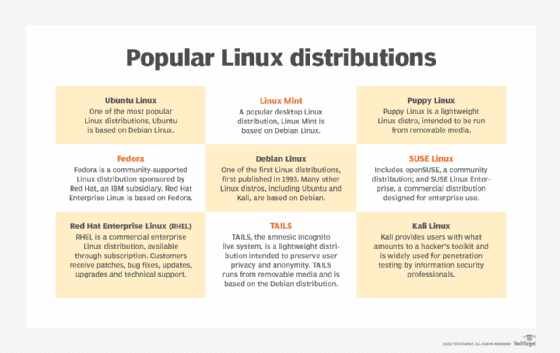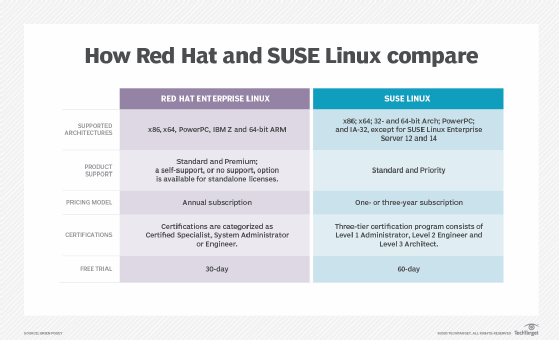SUSE
What is SUSE?
SUSE (pronounced soo-sah) is a multinational company that offers enterprise-grade Open Source products based on Linux technologies. The company was originally based in Germany, but it is now headquartered in Luxembourg, with offices located all over the world.
SUSE is similar to Red Hat. It assembles the Linux kernel and other open source components into a stable, full-featured Linux operating system (OS) available for purchase.
SUSE offers multiple editions of its OS to support different types of environments and workloads. For many organizations, buying a fully assembled Linux-based platform is preferable to investing the time and resources in installing and maintaining a free, open source Linux distribution. With a purchased product, customers get a stable system that comes with documentation and tech support. In some cases, this can result in a lower cost of ownership compared to implementing an unsupported version of the Linux OS.

SUSE products
SUSE was one of the first companies to commercialize the Linux kernel. What started as a modest effort 30 years ago has grown into a global company that plays a leading role in Linux innovation. SUSE offers nearly 20 products in the following four categories:
- Server. The server products include the company's flagship OS -- SUSE Linux Enterprise Server (SLES) -- as well as editions for three IBM platforms: IBM Z, LinuxOne and Power Systems. SUSE also offers an enterprise server product for the 64-bit Arm architecture.
- Environments. This category serves as a catch-all for a mix of products, including SUSE Linux Enterprise Desktop, SLES for SAP Applications, SUSE Linux Enterprise Real Time, SUSE Linux Enterprise Micro, SUSE Linux Enterprise High Performance Computing and SUSE in the public cloud.
- Management and extensions. Included in this category are SUSE Manager, SUSE Linux Enterprise Live Patching and SUSE Linux Enterprise High Availability Extension.
- SUSE Rancher. This category is products that came out of SUSE's acquisition of Rancher Labs in 2020. They include SUSE Rancher, SUSE Rancher Hosted, Rancher Kubernetes Engine, K3s and Rancher Longhorn, all of which focus on Kubernetes management.

SUSE milestones
Important dates in SUSE's history include the following:
- 1992. SUSE was founded by Roland Dyroff, Thomas Fehr, Hubert Mantel and Burchard Steinbild. At the time, the company name was spelled SuSE (lowercase u). SuSE was an abbreviation for Gesellschaft für Software und Systementwicklung mbH, which loosely translates to "software and system development company. In the same year, the founders introduced the first distribution of its Linux-based OS, Softlanding Linux System (SLS).
- 1994. The company released S.u.S.E. Linux 1.0, a Slackware-based OS.
- 1996. SUSE released S.u.S.E. Linux 4.2 based on Jurix, rather than Slackware. The company considered this to be its first true SUSE distribution.
- 1997. The SuSE OS became Europe's leading Linux distribution, and the company entered the North American market.
- 1999. SuSE formed partnerships with IBM, SAP and Oracle and entered the Asia-Pacific market. It also developed Yet another Setup Tool (YaST), an installation and configuration framework.
- 2000. The company released the first version of SLES, an OS for IBM S/390.
- 2001. SuSE released SLES for the X86 architecture.
- 2002. SuSE formed partnerships with Intel, AMD, Fujitsu and Hewlett-Packard.
- 2003. SuSE introduced SUSE Linux Enterprise Desktop for business and changed its name to SUSE with an uppercase "U."
- 2004. Novell acquired SUSE and launched openSUSE.
- 2006. SUSE and Microsoft announced an interoperability agreement. SUSE integrated the Xen hypervisor into SLES.
- 2007. SUSE released SUSE Linux Enterprise Server 10.
- 2009. SUSE released SLES 11 with the KVM hypervisor and introduced SUSE Studio.
- 2010. SUSE formed a partnership with VMware, and SUSE Linux Enterprise became available on Amazon Elastic Compute Cloud, or EC2.
- 2012. SUSE Linux Enterprise Server became available on Windows Azure. SUSE launched SUSECON, its annual user conference in North America.
- 2014. SUSE joined the Micro Focus Group. It releases SUSE Linux Enterprise Server 12 and SUSE Manager.
- 2015. SUSE joined Cloud Foundry and introduced SUSE Enterprise Storage based on Ceph.
- 2016. SUSE acquired openATTIC storage management platform.
- 2017. SUSE introduced the SUSE Cloud Application Platform with Cloud Foundry certification. SUSE also released its SUSE Containers as a Service Platform.
- 2018. SUSE Linux Enterprise 15 was released.
- 2019. SUSE partnered with EQT to become largest independent, open source software vendor in the world.
- 2020. SUSE acquired Rancher Labs for its Kubernetes expertise.
- 2021. SUSE released SUSE Linux Enterprise Server 15 SP3.
Learn more about the five leading enterprise Linux distributions.






